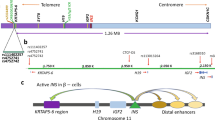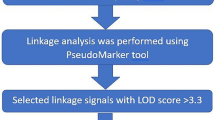Abstract
Genome-wide association (GWA) studies to map common disease susceptibility loci have been hugely successful, with over 300 reproducibly associated loci reported to date1. However, these studies have not yet provided convincing evidence for any susceptibility locus subject to parent-of-origin effects. Using imputation to extend existing GWA datasets2,3,4, we have obtained robust evidence at rs941576 for paternally inherited risk of type 1 diabetes (T1D; ratio of allelic effects for paternal versus maternal transmissions = 0.75; 95% confidence interval (CI) = 0.71–0.79). This marker is in the imprinted region of chromosome 14q32.2, which contains the functional candidate gene DLK1. Our meta-analysis also provided support at genome-wide significance for a T1D locus at chromosome 19p13.2. The highest association was at marker rs2304256 (odds ratio (OR) = 0.86; 95%CI = 0.82–0.90) in the TYK2 gene, which has previously been associated with systemic lupus erythematosus5 and multiple sclerosis6.
This is a preview of subscription content, access via your institution
Access options
Subscribe to this journal
Receive 12 print issues and online access
$259.00 per year
only $21.58 per issue
Buy this article
- Purchase on SpringerLink
- Instant access to full article PDF
Prices may be subject to local taxes which are calculated during checkout

Similar content being viewed by others
References
Hindorff, L.A., Junkins, H.A., Mehta, J.P. & Manolio, T.A. A catalog of published genome-wide association studies (Office of Population Genomics, National Human Genome Research Institute, Bethesda, Maryland, USA, accessed 9 November 2009) <http://www.genome.gov/gwastudies/>.
Wellcome Trust Case Control Consortium. Genome-wide association study of 14,000 cases of seven common diseases and 3,000 shared controls. Nature 47, 661–678 (2007).
Cooper, J.D. et al. Meta-analysis of genome-wide association study data identifies additional type 1 diabetes risk loci. Nat. Genet. 40, 1399–1401 (2008).
Barrett, J.C. et al. Genome-wide association study and meta-analysis find that over 40 loci affect risk of type 1 diabetes. Nat. Genet. 41, 703–707 (2009).
Suarez-Gestal, M. et al. Replication of recently identified systemic lupus erythematosus genetic associations: a case-control study. Arthritis Res. Ther. 11, R69 (2009).
Mero, I.L. et al. A rare variant of the TYK2 gene is confirmed to be associated with multiple sclerosis. Eur J. Hum. Genet. published online, doi:10.1038/ejhg.2009.195 (4 November 2009).
Clayton, D. & Leung, H.T. An R package for analysis of whole-genome association studies. Hum. Hered. 64, 45–51 (2007).
Wellcome Trust Case Control Consortium. et al. Association scan of 14,500 nonsynonymous SNPs in four diseases identifies autoimmunity variants. Nat. Genet. 39, 1329–1337 (2007).
Spencer, C.C.A. et al. The influence of recombination on human genetic diversity. PLoS Genet. 2, e148 (2006).
Hagan, J.P. et al. At least ten genes define the imprinted Dlk1-Dio3 cluster on mouse chromosome 12qF1. PLoS One 4, e4352 (2009).
Weinberg, C.R. et al. A log-linear approach to case-parent-triad data: assessing effects of disease genes that act either directly or through maternal effects and that may be subject to parental imprinting. Am. J. Hum. Genet. 62, 969–978 (1998).
Edwards, C.A. et al. The evolution of the DLK1–DIO3 imprinted domain in mammals. PLoS Biol. 6, e135 (2008).
Arney, K.L. H19 and Igf2 – enhancing the confusion? Trends Genet. 19, 17–23 (2003).
Lin, S.P. et al. Asymmetric regulation of imprinting on the maternal and paternal chromosomes at the Dlk1-Gtl2 imprinted cluster on mouse chromosome 12. Nat. Genet. 35, 97–102 (2003).
Steshina, E.Y. et al. Loss of imprinting at the Dlk1-Gtl2 locus caused by insertional mutagenesis in the Gtl2 5′ region. BMC Genet. 7, 44 (2006).
Jensen, C.H. et al. Protein structure of fetal antigen 1 (FA1). A novel circulating human epidermal-growth-factor-like protein expressed in neuroendocrine tumors and its relation to the gene products of dlk and pG2. Eur. J. Biochem. 225, 83–92 (1994).
Laborda, J. The role of the epidermal growth factor-like protein dlk in cell differentiation. Histol. Histopathol. 15, 119–129 (2000).
Tornehave, D. et al. FA1 immunoreactivity in endocrine tumours and during development of the human fetal pancreas; negative correlation with glucagon expression. Histochem. Cell Biol. 106, 535–542 (1996).
Sakajiri, S. et al. Dlk1 in normal and abnormal hematopoiesis. Leukemia 19, 1404–1410 (2005).
Raghunandan, R. et al. Dlk1 influences differentiation and function of B lymphocytes. Stem Cells Dev. 17, 495–507 (2008).
Abdallah, B.M. et al. dlk1/FA1 regulates the function of human bone marrow mesenchymal stem cells by modulating gene expression of pro-inflammatory cytokines and immune response-related factors. J. Biol. Chem. 282, 7339–7351 (2007).
Bennett, S.T. et al. Insulin VNTR allele-specific effect in type 1 diabetes depends on identity of untransmitted paternal allele. the IMDIAB group. Nat. Genet. 17, 350–352 (1997).
Stacey, S.N. et al. New common variants affecting susceptibility to basal cell carcinoma. Nat. Genet. 41, 909–914 (2009).
Plagnol, V. et al. A method to address differential bias in genotyping in large-scale association studies. PLoS Genet. 3, e74 (2007).
Gentleman, R.C. et al. Bioconductor: open software development for computational biology and bioinformatics. Genome Biol. 5, R80 (2004).
Chapman, J.M. et al. Detecting disease associations due to linkage disequilibrium using haplotype tags: a class of tests and the determinants of statistical power. Hum. Hered. 56, 18–31 (2003).
Clayton, D. et al. Use of unphased multilocus genotype data in indirect association studies. Genet. Epidemiol. 27, 415–428 (2004).
Vella, A. et al. Localization of a type 1 diabetes locus in the IL2RA/CD25 region by use of tag single-nucleotide polymorphisms. Am. J. Hum. Genet. 76, 773–779 (2005).
Marchini, J. et al. A new multipoint method for genome-wide association studies by imputation of genotypes. Nat. Genet. 39, 906–913 (2007).
Browning, B.L. & Browning, S.R. A unified approach to genotype imputation and haplotype-phase inference for large data sets of trios and unrelated individuals. Am. J. Hum. Genet. 84, 210–223 (2009).
Mantel, N. Chi-square tests with one degree of freedom: Extensions of the Mantel-Haenszel procedure. J. Am. Stat. Assoc. 58, 690–700 (1963).
Clayton, D. Testing for association on the X chromosome. Biostatistics 9, 593–600 (2008).
Weinberg, C.R. Methods for detection of parent-of-origin effects in genetic studies of case-parents triads. Am. J. Hum. Genet. 65, 229–235 (1999).
Acknowledgements
This work was funded by the Juvenile Diabetes Research Foundation International, the Wellcome Trust and the National Institute for Health Research Cambridge Biomedical Centre. The Cambridge Institute for Medical Research is in receipt of a Wellcome Trust Strategic Award (079895). We thank all study participants and family members.
We acknowledge use of DNA from the 1958 British Birth Cohort collection, funded by the Medical Research Council (grant G0000934) and the Wellcome Trust (grant 068545/Z/02). We thank The Avon Longitudinal Study of Parents and Children laboratory in Bristol and the British 1958 Birth Cohort team, including S. Ring, R. Jones, M. Pembrey, W. McArdle, D. Strachan and P. Burton, for preparing and providing the control DNA samples.
We acknowledge use of DNA from The UK Blood Services collection of Common Controls (UKBS collection), funded by the Wellcome Trust (grant 076113/C/04/Z), the Wellcome Trust/Juvenile Diabetes Research Foundation (grant 061858) and the National Institute of Health Research of England. The collection was established as part of the Wellcome Trust Case-Control Consortium.
We thank D. Dunger, B. Widmer and the British Society for Paediatric Endocrinology and Diabetes for the TID case collection.
We acknowledge use of DNA from the Human Biological Data Interchange and Diabetes UK for the USA and UK multiplex families, respectively; the Norwegian Study Group for Childhood Diabetes (D. Undlien and K. Ronningen) for the Norwegian families; D. Savage, C. Patterson, D. Carson and P. Maxwell for the Northern Irish families; the Genetics of Type 1 Diabetes in Finland (GET1FIN); J. Tuomilehto, L. Kinnunen, E. Tuomilehto-Wolf, V. Harjutsalo and T. Valle for the Finnish families; and C. Guja and C. Ionescu-Tirgoviste for the Romanian families.
This research used resources provided by the Type 1 Diabetes Genetics Consortium, a collaborative clinical study sponsored by the US National Institute of Diabetes and Digestive and Kidney Diseases, the US National Institute of Allergy and Infectious Diseases, the US National Human Genome Research Institute, the US National Institute of Child Health and Human Development and the Juvenile Diabetes Research Foundation International, and was supported by U01 DK062418.
This study made use of data generated by the Wellcome Trust Case Control Consortium. A full list of the investigators who contributed to the generation of the data is available from http://www.wtccc.org.uk. Funding for the project was provided by the Wellcome Trust under award 076113.
We acknowledge the US National Institute of Mental Health for generously allowing the use of their control CEL and genotype data. Control subjects from the National Institute of Mental Health Schizophrenia Genetics Initiative, data and biomaterials are being collected by the Molecular Genetics of Schizophrenia II collaboration. The investigators and coinvestigators are as follows: P.V. Gejman (collaboration coordinator) and A.R. Sanders (Evanston Northwestern Healthcare–Northwestern University, grant MH059571); F. Amin (Emory University School of Medicine, MH59587); N. Buccola (Louisiana State University Health Sciences Center, MH067257); W. Byerley (University of California, Irvine, MH60870); C.R. Cloninger (Washington University in St. Louis, U01 and MH060879); R. Crowe (principal investigator) and D. Black (University of Iowa, MH59566); R. Freedman (University of Colorado, MH059565); D. Levinson (University of Pennsylvania, MH061675); B. Mowry (University of Queensland, MH059588); and J. Silverman (Mt. Sinai School of Medicine, MH59586). The samples were collected by V.L. Nimgaonkar's group at the University of Pittsburgh as part of a multi-institutional collaborative research project with J. Smoller and P. Sklar (Massachusetts General Hospital, MH63420).
We acknowledge the US National Institutes of Health for allowing the use of their control-allele signal intensity and genotype data. The data sets used for the analyses described in this manuscript were obtained from the GAIN database, controlled through dbGaP accession number phs000018.v1.p1.
We thank H. Stevens, P. Clarke, G. Coleman, S. Duley, D. Harrison, S. Hawkins, T. Mistry and N. Taylor for preparation of DNA samples; and A. Ferguson-Smith for helpful advice on the chromosome 14q32 region.
Author information
Authors and Affiliations
Contributions
C.W. contributed to the design and interpretation of the study, conducted the statistical analyses and drafted the manuscript. D.J.S. conducted genotyping of the three SNPs for replication. M.M.-A. was responsible for the preparation and quality control of DNA samples. N.M.W. was responsible for data management. J.A.T. and D.G.C. contributed to the design and interpretation of the study and drafting of the manuscript. D.G.C. also contributed to the statistical analysis and development of methods for parent-of-origin effects testing.
Corresponding author
Supplementary information
Supplementary Text and Figures
Supplementary Figures 1 and 2 and Supplementary Tables 1–6 (PDF 190 kb)
Rights and permissions
About this article
Cite this article
Wallace, C., Smyth, D., Maisuria-Armer, M. et al. The imprinted DLK1-MEG3 gene region on chromosome 14q32.2 alters susceptibility to type 1 diabetes. Nat Genet 42, 68–71 (2010). https://doi.org/10.1038/ng.493
Received:
Accepted:
Published:
Issue date:
DOI: https://doi.org/10.1038/ng.493
This article is cited by
-
Genome-wide differential expression profiling of long non-coding RNAs in FOXA2 knockout iPSC-derived pancreatic cells
Cell Communication and Signaling (2023)
-
The rs3931283/PVT1 and rs7158663/MEG3 polymorphisms are associated with diabetic kidney disease and markers of renal function in patients with type 2 diabetes mellitus
Molecular Biology Reports (2023)
-
RNA-Sequencing Reveals Gene Expression and Pathway Signatures in Umbilical Cord Blood Affected by Birth Delivery Mode
Phenomics (2023)
-
The countdown to type 1 diabetes: when, how and why does the clock start?
Diabetologia (2023)
-
Longitudinal DNA methylation differences precede type 1 diabetes
Scientific Reports (2020)



